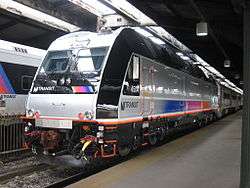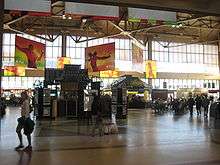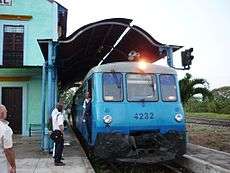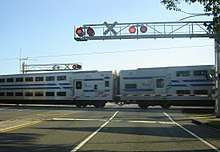Commuter rail in North America
Commuter rail services in the United States, Canada, Cuba, Mexico, Panama, and Costa Rica provide common carrier passenger transportation along railway tracks, with scheduled service on fixed routes on a non-reservation basis, primarily for short-distance (local) travel between a central business district and adjacent suburbs and regional travel between cities of a conurbation. It does not include rapid transit or light rail service.


Services
Many, but not all, newer commuter railways offer service during peak times only, with trains into the central business district during morning rush hour and returning to the outer areas during the evening rush hour. This mode of operation is, in many cases, simplified by ending the train with a special passenger carriage (referred to as a cab car), which has an operating cab and can control the locomotive remotely, to avoid having to turn the train around at each end of its route. Other systems avoid the problem entirely by using bi-directional multiple units.
Other commuter rail services, many of them older, long-established ones, operate seven days a week, with service from early morning to after midnight. On these systems, patrons use the trains not just to get to and from work or school, but also for attending sporting events, concerts, theatre, and the like. Some also provide service to popular weekend getaway spots and recreation areas. The Long Island Rail Road (LIRR) is the only commuter railroad that operates 24 hours a day, 7 days a week in North America.
Almost all commuter rail services in North America are operated by government entities or quasi-governmental organizations. Most share tracks or rights-of-way used by longer-distance passenger services (e.g. Amtrak, Via Rail), freight trains, or other commuter services. The 600-mile-long (970 km) electrified Northeast Corridor in the United States is shared by commuter trains and Amtrak's Acela Express, regional, and intercity trains.
Commuter rail operators often sell reduced-price multiple-trip tickets (such as a monthly or weekly pass), charge specific station-to-station fares, and have one or two railroad stations in the central business district. Commuter trains typically connect to metro or bus services at their destination and along their route.
After the completion of SEPTA Regional Rail's Center City Commuter Connection in 1981, which allowed through-running between two formerly separate radial networks, the term "regional rail" began to be used to refer to commuter rail (and sometimes even larger heavy rail and light rail) systems that offer bidirectional all-day service and may provide useful connections between suburbs and edge cities, rather than merely transporting workers to a central business district.[1] This is different from the European use of "regional rail", which generally refers to services midway between commuter rail and intercity rail that are not primarily commuter-oriented.
Spread

The two busiest passenger rail stations in the United States are Pennsylvania Station and Grand Central Terminal, which are both located in the Borough of Manhattan in New York City, and which serve three of the four busiest commuter railroads in the United States (the Long Island Rail Road and NJ Transit at Penn Station, and the Metro-North Railroad at Grand Central Terminal). The commuter railroads serving the Chicago area are Metra (the fourth-busiest commuter railroad in the United States) and the South Shore Line. Other notable commuter railroad systems include SEPTA Regional Rail (fifth-busiest in the US), serving the Philadelphia area; MBTA Commuter Rail (sixth-busiest in the US), serving the Greater Boston-Providence area; Caltrain, serving the area south of San Francisco along the peninsula as far as San Jose; and Metrolink, serving the 5-county Los Angeles area.
There are only three commuter rail agencies in Canada: GO Transit in Toronto (the fifth-busiest in North America), Exo in Montreal (eight-busiest in North America), and West Coast Express in Vancouver. The two busiest rail stations in Canada are Union Station in Toronto and Central Station in Montreal.

Commuter rail networks outside of densely populated urban areas like the Washington D.C., New York, Chicago, Philadelphia, Boston, San Francisco, Montreal, and Toronto metropolitan areas have historically been sparse. Since the 1990s, however, several commuter rail projects have been proposed and built throughout the United States, especially in the Sun Belt and other regions characterized by urban sprawl that have traditionally been underserved by public transportation. Since then, commuter rail networks have been inaugurated in Dallas–Fort Worth, Los Angeles, San Diego, Minneapolis, Denver, Salt Lake City, and Orlando, among other cities. Several more commuter rail projects have been proposed and are in the planning stages.
Rolling stock

Commuter trains are either powered by diesel-electric or electric locomotives, or else use self-propelled cars (some systems use both). A few systems, particularly around New York City, use electric power, supplied by a third rail and/or overhead catenary wire, which provides quicker acceleration, lower noise, and fewer air-quality issues. Philadelphia's SEPTA Regional Rail uses exclusively electric power, supplied by overhead catenary wire.
Diesel-electric locomotives based on the EMD F40PH design as well as the MP36PH-3C are popular as motive power for commuter trains. Manufacturers of coaches include Bombardier, Kawasaki, Nippon Sharyo, and Hyundai Rotem. A few systems use diesel multiple unit vehicles, including WES Commuter Rail near Portland and Austin's Capital MetroRail. These systems use vehicles supplied by Stadler Rail or US Railcar (formerly Colorado Railcar).
In terms of ridership, Canadian systems tend to have dramatically higher per capita ridership than American counterparts, echoing patterns in light rail transit and other system types.
List of North American commuter rail operators
List of under construction and planned systems
There are several commuter rail systems currently under construction or in development in Canada, Mexico and the United States.
| Under construction | |
Former
The following systems have ceased operations since the formation of Amtrak in 1971.
- CalTrain, Oxnard to Los Angeles (1982-1983)
- Champlain Flyer, Burlington, Vermont (2000-2003)
- Former Erie-Lackawanna, later Conrail, service between Cleveland and Youngstown, Ohio (until 1977)
- Former Milwaukee Road service from Milwaukee to Watertown, Wisconsin (until 1972)[47]
- OnTrack, Syracuse, New York (1994-2007)
- Parkway Limited, Pittsburgh, PA (1981)
- PATrain, Pittsburgh, PA (1979-1989)
- Pittsburgh and Lake Erie Railroad service from Pittsburgh to Beaver Falls, Pennsylvania (until 1985)[48]
- SEMTA, Detroit, Michigan (1974-1983)
See also
- Interurban
- List of airport circulators
- List of metro systems
- List of suburban and commuter rail systems
- List of rail transit systems in the United States
- List of tram and light rail transit systems
- List of United States commuter rail systems by ridership
- Northeast Corridor
- Public transport
- Regional rail
- Transit (transportation)
- Transportation in New York City
Notes
- State sponsored Amtrak route with commuter rail focus
- This figure is from NJ Transit's Fiscal Year 2017, which covers the calendar period July 2016 to June 2017.
- The proposal in Ottawa is actually 2 organizations proposing similar systems.
References
- "Public Transportation: Bus, Rail, Ridesharing, Paratransit Services, and Transit Security" (PDF). Transportation Research Record. Transportation Research Board. 1433: 81–112. 1994.
- "Transit Ridership Report Fourth Quarter 2018" (PDF). American Public Transportation Association (APTA). April 12, 2019. Retrieved May 8, 2019 – via https://www.apta.com/wp-content/uploads/2018-Q4-Ridership-APTA.pdf.
- "Five Years of FrontRunner". rideuta.com. Utah Transit Authority. April 25, 2013. Retrieved 2014-01-08.
- Transportation, Department of. "ConnDOT: New Haven-Hartford-Springfield Commuter Rail Implementation Plan". www.ct.gov. Retrieved 7 April 2018.
- "2017 New Jersey Transit Annual Report | NJOIT Open Data Center". data.nj.gov. Retrieved 2019-04-21.
- Panama Canal rail traffic hit by computer glitch, Reuters, 22 March 2013.
- "EL TREN SUBURBANO HA TRANSPORTADO A 57 MILLONES DE PERSONAS EN EL 2017". Ferrocarriles Suburbano. Ferrocarriles Suburbanos. 14 December 2017. Retrieved 11 May 2019.
- https://www.halifax.ca/transit/commuterrail.php%5B%5D
- "home - Moose Consortium Inc". Moose Consortium Inc. Retrieved 2017-05-01.
- Transport Pontiac-Renfrew Archived 2013-04-23 at the Wayback Machine
- http://www.cddhcu.gob.mx/comisiones59legislatura/transportes/foro/Dr_Martinez.pdf%5B%5D
- "Archived copy" (PDF). Archived from the original (PDF) on 2008-06-25. Retrieved 2008-04-16.CS1 maint: archived copy as title (link)
- http://www.notisistema.com/noticias/?p=130621%5B%5D
- http://www.milenio.com/node/113320%5B%5D
- "Tren InterUrbano". treninterurbano.cdmx.gob.mx. Retrieved 7 April 2018.
- "Tri-Valley - San Joaquin Valley Regional Rail Authority". Retrieved 30 May 2018.
- "AB-758 Transportation: Tri-Valley-San Joaquin Valley Regional Rail Authority". Retrieved 17 October 2017.
- "The Official Site of the Alaska Railroad - Travel Alaska - Rail train travel, tours, and freight transportation for the Last Frontier". webarchive.loc.gov. Archived from the original on 8 August 2002. Retrieved 7 April 2018.
- "Archived copy". Archived from the original on 2005-05-11. Retrieved 2006-07-18.CS1 maint: archived copy as title (link)
- "Wallyrail.org". www.wallyrail.org. Archived from the original on 8 April 2018. Retrieved 7 April 2018.
- The Ride - Ann Arbor Transportation Authority Archived 2012-10-13 at the Wayback Machine
- "Clayton County". MARTA. Retrieved 15 January 2019.
- "Red Line Project". Charlotte Area Transit System (CATS). Retrieved 2014-09-06.
- "Home". RedLine Regional Rail. Archived from the original on 2014-09-06. Retrieved 2014-09-06.
- Appendix D Archived 2010-12-29 at the Wayback Machine
- Ohio News - OH News | The Morning Journal Archived 2007-09-27 at the Wayback Machine
- Rachel Carson (2007-01-13). "Lorain to Cleveland commuter rail | GreenCityBlueLake". Gcbl.org. Archived from the original on 2012-09-22. Retrieved 2012-08-15.
- Oasis Rail Transit Introduction Archived 2011-07-16 at the Wayback Machine
- "Cotton Belt Public Private Partnership Request for Information". DART.org. Retrieved 2012-08-15.
- "Annar Borde Troitrapid Transitstud - Find Your True Transitstud Today!". www.annarbordetroitrapidtransitstudy.com. Archived from the original on 8 April 2018. Retrieved 7 April 2018.
- (PDF) https://web.archive.org/web/20070816070736/http://www.annarbordetroitrapidtransitstudy.com/news/pdfs/CRT01%20Board%20091505.pdf. Archived from the original (PDF) on August 16, 2007. Retrieved December 24, 2006. Missing or empty
|title=(help) - (PDF) https://web.archive.org/web/20070928025601/http://www.annarbordetroitrapidtransitstudy.com/news/pdfs/CRT02%20Board%20091505.pdf. Archived from the original (PDF) on September 28, 2007. Retrieved December 24, 2006. Missing or empty
|title=(help) - Basnet, Neetish (3 January 2019). "Burleson first on list for new commuter rail service". Burleson Star. Retrieved 15 January 2019.
- "Archived copy". Archived from the original on 2007-05-29. Retrieved 2007-04-10.CS1 maint: archived copy as title (link)
- "Welcome to our Site". mtptransit.org. Retrieved 7 April 2018.
- METRO, webmaster@ridemetro.org. "METRO Home". www.ridemetro.org. Retrieved 7 April 2018.
- "All about Metro and public transport vehicles in the United States". Metrosolutions.org. Archived from the original on 2013-04-15. Retrieved 2012-08-15.
- Dane County Commuter Rail Archived 2007-04-09 at the Wayback Machine
- "Transport 2020 Project Site". www.transport2020.net. Retrieved 7 April 2018.
- "Brightline in talks with Miami-Dade to run commuter-rail line, report says". Progressive Railroading. 29 May 2020. Retrieved 31 May 2020.
- Price-Williams, Abigail. "MEMORANDUM" (PDF). Miami Dade County. Retrieved 31 May 2020.
- "redrockrail.org - Cocktail im Casino trinken". www.redrockrail.org. Retrieved 7 April 2018.
- "Eastern Corridor Transit Study: Transitional Analysis To Locally Preferred Alternatives". www.spcregion.org. Archived from the original on 7 May 2017. Retrieved 7 April 2018.
- "Archived copy". Archived from the original on 2008-06-28. Retrieved 2008-01-08.CS1 maint: archived copy as title (link)
- "Durham-Wake Corridor". ourtransitfuture.com. Archived from the original on 2 April 2015. Retrieved 7 April 2018.
- "Moving Transit Forward - Metro Transit – St. Louis". www.movingtransitforward.org. Retrieved 7 April 2018.
- Sanders, Craig (2006). Amtrak in the Heartland. Bloomington, Indiana: Indiana University Press. p. 184. ISBN 978-0-253-34705-3.
- Baer, Christopher T. (April 2015). "A GENERAL CHRONOLOGY OF THE PENNSYLVANIA RAILROAD COMPANY ITS PREDECESSORS AND SUCCESSORS AND ITS HISTORICAL CONTEXT: 1980-1989" (PDF). Pennsylvania Railroad Technical & Historical Society.